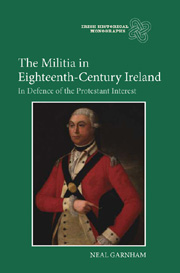Book contents
- Frontmatter
- Contents
- Preface
- Acknowledgments
- Abbreviations
- Introduction: Militia issues
- 1 To 1691: Precursors
- 2 1692–1716: Establishment
- 3 1716–59: Maintenance
- 4 1760: Action
- 5 1761–69: Reform Debated and Attempted
- 6 1769–78: Reform Achieved
- 7 1778–82: Volunteering Ascendant
- 8 1782–85: Fencible Men and the Militia Reconsidered
- 9 1785–93: Indecision and an Act
- 10 Conclusions
- Bibliography
- Index
3 - 1716–59: Maintenance
Published online by Cambridge University Press: 05 February 2013
- Frontmatter
- Contents
- Preface
- Acknowledgments
- Abbreviations
- Introduction: Militia issues
- 1 To 1691: Precursors
- 2 1692–1716: Establishment
- 3 1716–59: Maintenance
- 4 1760: Action
- 5 1761–69: Reform Debated and Attempted
- 6 1769–78: Reform Achieved
- 7 1778–82: Volunteering Ascendant
- 8 1782–85: Fencible Men and the Militia Reconsidered
- 9 1785–93: Indecision and an Act
- 10 Conclusions
- Bibliography
- Index
Summary
The creation of a statutory militia in Ireland marked out a new phase in the force's development. For the first time the militia had its foundations in law, and not just in established practice and precedent. The 1716 act had been passed in the wake of a threatened invasion. Earlier attempts to pass such legislation had failed for a variety of reasons. For some at least, the final act was a compromise, with Dissenters barred from commissioned service. The act's passage underlines the complexities of the legislative system, and the divisions within it. Clashes over the militia had taken place on party grounds, and between the upper and lower houses of the Irish parliament. English and Irish interests also came to be at odds. However, a force controlled by law, and in which the legislature and the executive had their parts to play, had been established. The militia would exist in this form, at least on paper, for the next sixty years.
The 1716 act ‘to make the militia of this kingdom more useful’ contained 15 clauses. These stipulated that all Protestant males between 16 and 60 should be listed for possible service, with those failing to appear being fined. Commissions of array were to be issued by the Crown when required, while officers were to be nominated by the lieutenant governors of each county. Town militias could be called out by their officers as necessary.
- Type
- Chapter
- Information
- The Militia in Eighteenth-Century IrelandIn Defence of the Protestant Interest, pp. 35 - 59Publisher: Boydell & BrewerPrint publication year: 2012

